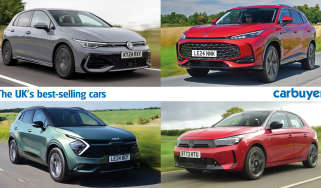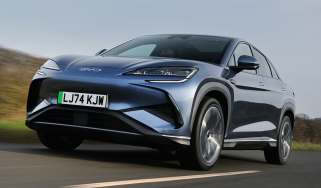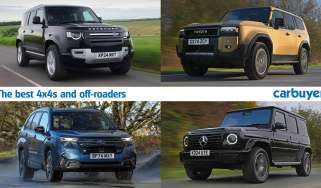What car should I buy? Car-choosing checklist
Looking for a new car but not sure where to start? We’ll guide you through the steps to finding the right model for you
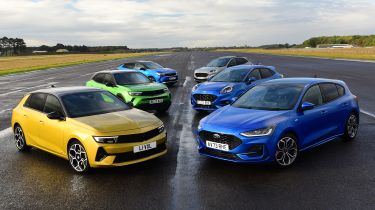
Choosing what car to buy can be an exciting but overwhelming experience. With countless models available it’s crucial to consider what you need the vehicle for and how much you’re willing to spend. Whether you have a specific bodystyle in mind or are still exploring your options, understanding how a car fits into your lifestyle and budget is key.
As tempting as it is to go for the model that catches your eye with a fancy colour, attractive looks or a prestigious badge, it can pay off in the long run if you approach the buying process systematically – that’s where we at Carbuyer are here to help. Our guide is designed to simplify your decision-making by providing relevant, practical advice.
We recommend that you take a look at our Best Car lists once you’ve narrowed down a price range or bodystyle, along with our Driver Power survey results, which use the real life experiences from owners to determine what cars are best to live with. Our guide to working out car costs will be useful, too, along with our guide to car finance.
Ultimately only you know your lifestyle, tastes and budget as these factors are unique to each buyer. This guide will help you work out what you need a car for and put together a checklist for the best option. We’ve also put together in-depth articles on car insurance, road tax, warranties and more, so be sure to have a look if you’d like to know more.
Things to consider when buying your next car
- How much you want to spend to buy or lease the car, and the subsequent running costs
- What you’ll use the car for
- How much space you need
- What features you need or want
- Whether it should be petrol, diesel, hybrid or electric
New or used?
Setting a budget is often the first step of the car buying process, and it will usually dictate whether you’re shopping for a new or used car.
Buying new allows you to spec your car exactly to your taste, with your desired options and in the colour you want. You’ll also benefit from the manufacturer’s warranty, which usually runs for a minimum of three years. However, new cars tend to have long lead times, which means you could be waiting for a while for your new set of wheels. There’s also the issue of depreciation; a new car is likely to lose more of its value than a used car over the same period of time.
Used cars, meanwhile, have their own benefits. A used car will almost always be cheaper than its new equivalent and its first owner is likely to have taken the initial hit of depreciation so you don’t have to. A good place to start your used-car hunt is on an ‘approved’ used forecourt, where cars come with added backup from manufacturers – such as a rigorous pre-sale inspection by specialist technicians. If the used car you’re buying is only a year or two old, it will probably still be covered by the manufacturer’s warranty, but dealers may provide a warranty for older cars, too. Read our guide to car warranties for a complete breakdown of everything you need to know.
How will you be using the car?
Now you know how much you want to spend, it’s time to consider what the car will predominantly be used for. What are the most frequent journeys you take? Do you stick to around-town driving, or are regularly eating up miles on the motorway?
If you’re predominantly going to be nipping around town, fuel economy might be a secondary concern (few cars are at their most efficient in stop-start traffic) but you might want a small car to make parking easier. Four-wheel drive, meanwhile, is usually unnecessary unless you’re planning to tow regularly or you live off the beaten track.
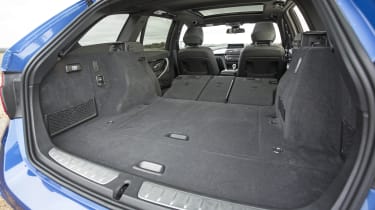
In a similar vein, how much space do you need? Do you need seven seats, or would a cheaper five-seat model suffice? Is there room for your family or friends in the back of the car, and is the boot big enough for the things you tend to carry? Would a higher ride height make it easier to get in and out? If you have bikes or canoes, would roof rails come in handy? Asking yourself questions like these narrows down your search criteria and helps make sure you’re getting a car that suits your requirements.
Decide on a bodystyle
What you’ll be using the car for will determine the bodystyle that’s best for you. Things aren’t as simple as they used to be, however. If you were buying a car two or three decades ago, hatchbacks were for those who stuck to urban driving, an estate was for those who needed to carry large loads regularly, while everyone else drove a saloon.
Today, SUVs are a lot more popular, thanks to their higher driving position and increased interior space – more modern offerings drive reasonably well and don’t use much more fuel than a conventional car. SUVs now come in all shapes and sizes, and have replaced many of the hatchbacks that were once popular with city drivers.

You may have also heard of the term ‘crossover’ – this was originally a term to refer to a car blending characteristics of two body styles, but is now used predominantly to refer to cars based on traditional small hatchbacks with the raised ride height or styling features of SUVs. It’s even possible to buy a soft-top SUV, such as the Volkswagen T-Roc Cabriolet, although that particular model is hard to recommend.
These are the body styles we tend to use on Carbuyer:
- City cars (eg. Fiat 500)
- Superminis (eg. Renault Clio)
- Small SUVs (eg. Ford Puma)
- Family hatchbacks (eg. Ford Focus)
- Mid-size SUVs (eg. Nissan Qashqai)
- Large family cars (eg. Skoda Superb)
- Estate cars (eg. Volkswagen Passat)
- Large SUVs (eg. Kia Sorento)
- MPVs (eg. Volkswagen Caddy)
- Executive cars (eg. BMW 3 Series)
- Coupes (eg. Mercedes CLE)
- Convertibles, sometimes called Cabriolets (eg. Mazda MX-5)
When you’re deciding what car to buy, keep in mind roughly what size of car you want, but be prepared to broaden your search in terms of shape and body style. If you’re after a traditional hatchback like the Volkswagen Golf, for instance, would the extra space available in a similarly priced Skoda Karoq SUV be useful, or is all that extra room just going to go to waste?
It’s a similar story with brands: you may be surprised at the level of equipment and sense of refinement in a car from a brand that was once considered ‘budget’. Similarly, you may find that stretching to a more premium brand is not as expensive as you thought, particularly if you consider the wide range of leasing options available today.
Whichever kind of car you’re in the market for, our series of articles detailing the Best Cars you can buy breaks them down according to body style, while also featuring recommendations based on what you’re going to need the car for – be it towing, avoiding the London Ultra Low Emission Zone, and more.
Petrol, diesel, hybrid or electric?
The next thing to consider is what fuels your car. Petrol-powered cars remain the most popular on sale today, but hybrid and electric models are becoming far more widespread as manufacturers ramp up towards the 2035 ban on the sale of petrol and diesel cars. Diesel cars have been declining in popularity for some time, and there are fewer options to choose from as a result, but they’re still a good solution for some drivers.

If you mainly stick to around-town driving, an efficient petrol car or a hybrid will probably suit you best. Today, there are different types of hybrids to choose from, including mild hybrids, full hybrids (sometimes called self-charging hybrids), and plug-in hybrids. These use a combination of combustion engine and electric motor to improve efficiency around town.
As a rule of thumb, if you cover fewer than 12,000 miles a year, a diesel engine may not be suitable. Diesel cars cost more to buy than their petrol counterparts, and you’ll need to cover quite a lot of miles to make up the difference in fuel savings. Conversely, most hybrid and plug-in hybrid models offer lower running costs than their petrol-only counterparts, but are more expensive to buy than a conventional petrol or diesel model.
You should also consider the type of journeys you’ll be doing in the car. If you mainly do short trips, a diesel is probably not for you, as diesel engines need to be run at speed regularly to burn off soot that collects in the Diesel Particulate Filter (DPF). If you don’t give a diesel engine the chance to do this from time to time, you could find yourself with a blocked DPF and a big repair bill. Our dedicated guide to choosing between petrol and diesel has more information.
If you plan to use your car for shorter journeys, then one of the best plug-in hybrid models could be a viable choice if you have access to a charging point. A large number of PHEV models, such as the Mercedes C-Class and Kia Niro, can be driven on electric power for over 40 miles, depending on how you drive them, a range that can often be sufficient to cover shorter commutes. Head out on a longer journey, and the petrol engine takes over like a traditional car.
Electric cars will offer the lowest running costs, so long as you’re able to charge at home. The UK public charging network is rapidly growing and offers the fastest charging speeds, but it costs considerably more to use than plugging into your own wallbox. Even if you don’t have access to off-street parking, we have a guide to charging at home if you don’t have a driveway. Electric cars are also exempt from road tax (VED) for now, although that will change from 1st April 2025.
The trade-off is that electric cars usually command a higher purchase price than their petrol or hybrid counterparts, but as the technology becomes more widespread, prices are expected to fall. We have a list of the cheapest electric cars if you’re looking to make the switch on a budget.
Range was also an issue for early adopters of electric cars, but battery technology has moved on and many modern EVs can manage over 300 miles on a charge. That should be enough to satisfy most drivers.
Work out what's essential
If you’ve got a rough idea of the size and shape of car that you’re after, think carefully about what you use it for. If you have small children, an SUV is a good bet, as the raised ride height makes getting kids and their seats into the car much easier. If you’re keen on DIY, carrying capacity may be important – but look out for cars that have easy-to-fold rear seats that lie flat when dropped. This is something we’ll always point out in our reviews.
If you need your car to have certain features, such as sat-nav, parking sensors or leather seats, try to go for a trim level that includes them all together, as this is usually better value than adding items individually as options. Specifying a new car’s options can be a tricky business; use our guide to car options for some help.
Each Carbuyer review contains details of every version of a car that you can buy, including engine choices and trim levels. It also includes technical information such as power and performance figures, as well as fuel economy and CO2 emissions data. We also list useful information about boot space, road tax bands and each trim’s standard equipment, so whether you prioritise performance, economy, technology or a combination of all three, our in-depth reviews will give you all the information you need at your fingertips.
Types of finance deals
The majority of new cars bought today are paid for using some form of finance. As dealers are encouraged to sell cars via this method, you’ll find that cash is not necessarily king, and you’re as likely to get a discount or deal by buying a car on finance. Our experts scour the web for the best finance deals each week, covering a wide range of bodystyles and price points.
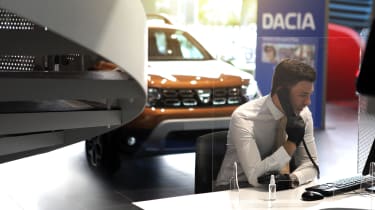
We’ve put together a comprehensive guide to buying a new car using finance, as well as specific guides to PCP deals, Hire Purchase agreements and Personal Contract Hire (leasing). If you’re using one of these methods to pay for a car, keep an eye on the total price as well as the monthly repayments; an optional extra may not seem that expensive on a monthly basis, but it’s easy to lose sight of the true cost of options, and you may not get your money back when it’s time to sell your car or trade it in.
Taking out a GAP insurance policy when buying via finance is also a good idea as, if you’re unlucky enough to write off your car, you could find yourself seriously out of pocket, adding insult to injury.
What are the running costs?
It’s tempting to stretch yourself as far as you can when setting a budget for a new car, and monthly repayments can be tantalisingly low – even for upmarket models. Be sure to bear in mind, however, that running costs are easily dismissed at the buying stage, and excessive fuel consumption or insurance premiums could leave you resenting your car.
With brand new cars, the first year’s VED payment (road tax) is included in the car’s price, and then you’ll pay a flat rate from the second year onwards. The current rates (as of April 2024) are £190 a year for a petrol or diesel car and £180 a year for mild-hybrids, hybrids and plug-in hybrids. Electric and hydrogen cars cost nothing in tax, but only until April 2025 when they will be taxed at the same rate as hybrid cars. Cars registered before April 2017 were subject to a different tax structure which took CO2 emissions and engine size into account – so you may pay much less or much more, depending on the car. Check out our full guide to UK road tax (VED) to find out how much your next car could cost to tax.
As of 2017, an additional surcharge for every car costing more than £40,000 (including any optional extras) was introduced. The surcharge is currently £410, which needs to be paid every year for the first five years after first registration. After the five year period ends, annual road tax returns to the flat rates mentioned above. Zero-emission cars are exempt from this extra surcharge for now, so even the most expensive EVs are free to tax.
If you’re a company-car driver, CO2 emissions will also affect how much Benefit-in-Kind (BiK) tax you pay, so be sure to take this into consideration too.
Fuel economy obviously needs to be taken into account. While manufacturers’ official figures have previously been hard to match in the real world, the introduction of the new 'WLTP' economy and emissions testing in 2017 means they are now more accurate. You should still take quoted figures with a pinch of salt because how and where you drive will affect fuel economy. This is even more important for plug-in hybrids; manufacturers will often quote astronomical, three-digit MPG figures which are near-impossible to achieve in the real world unless you spend most of your time in electric-only driving mode.
Keep an eye on the trip computer during any test drive for a more realistic economy figure, and ask the dealer to show you how to access this information if you’re unsure. If economy is important to you, our guide to the most economical cars on sale today is well worth reading.
Don’t forget to get some insurance quotes for any car you’re thinking of buying, as some models can cost significantly more to insure than others. If you’re a young driver, it may be worth looking at a ‘black box’ insurance policy, and our guide to the best first cars.
Make a shortlist of cars and test-drive them
If you know what engine and specification you want your car to have, try to test a model that’s as similar as possible. This is well worth doing; while it may mean you’ll have to wait for the dealer to get the right car delivered, different engine and gearbox combinations can completely alter the way a car drives, as can options like sports suspension and large alloy wheels. If you’re after sat-nav or in-car tech features like Bluetooth phone connectivity, check how well these work, as some systems are far superior to others. Luckily, most cars come with Apple CarPlay and Android Auto, so you can use your phone’s navigation and media apps on the screen instead of the car’s system.
If you’re buying a car for the family, take your partner and children along with you to see how they like the car. They may spot problems that you hadn’t considered, such as poor interior storage space or uncomfortable rear seats. It’s also a good idea to bring along any bulky items – such as children’s buggies or golf clubs – that you regularly carry, to see how well these fit in the boot.
On the test drive, be sure to drive along a variety of roads, from dual carriageways to twisty back roads. This will help you make a fuller assessment of the way the car handles. Some dealers may let you borrow a car over the weekend, and this can be helpful – though make sure you don’t become too attached to it, as maintaining a clear, objective approach is key. Our in-depth guide to test drives has more information.
The key focus of any test drive, obviously, is the car itself – so don’t let the salesperson distract you with small talk too much – though it pays to be polite if you want to strike a good deal! Speaking of which…
Get haggling
Once you’ve decided on which car to buy, it’s time to agree on a price. Some dealers are more open to haggling than others, but do phone round their competitors to see what offers are available elsewhere, and don’t be afraid to share this information with the salesperson; they want your business, after all. Our guide on negotiating a great price for your new car has more information.
If the car you’re after is a particularly new or in-demand model, discounts are likely to be rare. You should be able to get a set of car mats and a full tank of fuel thrown in, though.
Unless you’re buying an older second-hand car, you should also expect some kind of warranty, and aftermarket policies can offer extra peace of mind – though be sure to check what is and isn’t covered. Used cars that are between one and three years old can offer serious savings together with some remaining manufacturer’s warranty, while pre-registered cars offer something of a halfway house between the new and used market.
Of course, buying a new car often means you’ll want to sell your old car. We’ve covered the best ways to sell a car, as well as selling a car on eBay, and the best and worst times to sell a car – all could be useful if you’re looking to offload your old car. If you’re trading in an old car as part of the buying process, do your research and find out how to value your used car before you go shopping for a new car to be sure the dealer gives you a fair price.
Deciding which car to buy is an involved process, and many people try to get behind the wheel as soon as possible. Bear in mind, though, that time invested in finding the right car should pay dividends during the time you own it. Happy hunting!
Once you've bought your new car, you'll want to know how to look after it, read our basic car maintenance tips every motorist should know...
Recommended

Petrol and diesel car ban relaxed with hybrids permitted beyond 2030

Classic car tax exemption: which historic vehicles qualify?

Car warranties: guide to new and used car warranties
Most Popular

Best car leasing deals 2025: this week’s top PCH offers
Tips & advice

Car dashboard warning lights: what does each symbol mean?

Electric car charging stations: public networks, charger types, apps and maps



